Eight years in a city garden
Part 1: Building the bones and structure.
My husband and I purchased our quarter-acre property eight years ago. Those of you who’ve followed along since then have witnessed a series of trials and triumphs, including milestones such as our platinum award from the Audubon Society after just three years and moving our little blog to Substack in 2022.
Thanks for sticking with us all this time… especially those of you who’ve been following me even longer than these eight years of city gardening, if you originally found me via the Dreamslippers series books. Yeah, about a third of you harken all the way back to when Anthony and I lived in a small town in Washington state called Chehalis, and Seattle before that. Shout-out to all our friends in the Pacific Northwest!
With blood, sweat, and tears over these eight years, we finally achieved our vision: a productive, wildlife- and pollinator-friendly garden bursting with native plants, beneficial non-natives, and edibles.
When we bought the property in 2017, we got a great deal, likely in part because the backyard was what you might call a problem situation.
To the left you can see the zigzagging chainlink fence and the way the whole property butts up against the neighboring apartment building parking lot. Bonus: A view of the dumpsters! The yard was a relic of mid-century landscaping values, with big, fat circles of day lilies, hostas, and euphorbias, at that point overgrown with weeds and spilling into the grassy areas, which were also mostly weeds (not that we don’t appreciate weeds). I think a lot of potential buyers took one look at this yard and saw themselves having to do a lot of awkward mowing, not to mention constantly hacking away at nuisance foliage.
That first year, we didn’t do anything radical to the yard, or the house, for that matter, as we were still getting to know the place. It’s a good idea to sit with a big project like this, if you’re living in the place yourself, to come to understand it fully before diving in with major fixes. It was a chore, but we mowed the lawn and beat back the invasive overgrowth as best we could.
Our first step in the fall of 2018 was to invite experts from the St. Louis Audubon Society's Bring Conservation Home program to conduct a site visit. Based on their recommendations, we chose to remove our serious problem plants first, which at that time comprised the majority of the greenery. The chainlink fence was overgrown with invasive plants on every single side. The three culprits were: 1) winter creeper, 2) Japanese honeysuckle, and 3) sweet autumn clematis. These have been eradicated, though we continue to remove seedlings to this day.
Next we installed a six-foot cedar fence around the entire backyard, to provide privacy and security, as well as screen the view of the parking lot full of cars next door (and the dumpsters). The fence turns out to have had the added benefit of protecting our plantings from deer. You wouldn’t have thought there’d be a deer issue in the middle of a major metropolitan area with a population of three million people, but I’ve spotted them at a nearby pocket park. Not that we would mind deer, but without the fence, we would have had to devise another strategy to keep deer from the edibles and other plants.
For financial reasons, we split the fence job, completing the side between us and the apartment building during the summer and opting to finish in fall. I wasn’t sure they could dig the posts in as late as the week after Thanksgiving, but the fence contractor said it would be no problem.
In between, we had landscapers remove the honeysuckle, and what lay in wait underneath kind of horrified us.
You already saw the chainlink fence on the southeast side of the property, and it was eyesore enough, not to mention tough to remove since the winter creeper (which is supposed to be a ground cover) had woven itself up through the chainlink so that the fence and the creeper had essentially become one.
We assumed the fence on the rear and northwest sides would be the same. But we were wrong. It was worse.
Yeah, it looked like the edge of a demilitarized zone.
Although the honeysuckle vine was invasive, it had served as a rather attractive green screen. Taking it out left a large swath of bare, ugly fence topped with barbed wire.
But why? Who or what had they kept in? Or out?
We’ll never know. But that fence had to go.
We felt really exposed after the honeysuckle came down and before the fence crews began work, but once the fence started to take shape, the farmyard began to feel a lot cozier. And we got a ton of compliments from our neighbors on all sides.
After the fence, we put in the first set of trees and shrubs and began the long process of sheet-mulching the turf grass, as it was our intention to convert the entire grounds to mixed plantings, with little to no grass. We used a layer of cardboard with a generous helping of mulch on top. We scavenged most of the cardboard from our neighbors’ recycling bins and a local brewery’s box-discard dumpster and ordered the mulch in bulk for the cost savings.
See my how-to on sheet-mulching, which is really easy, especially if you’re talking about a small plot of land. But here’s a glimpse of what it entails for a project of this scale. To mulch a quarter acre, you need a lot.
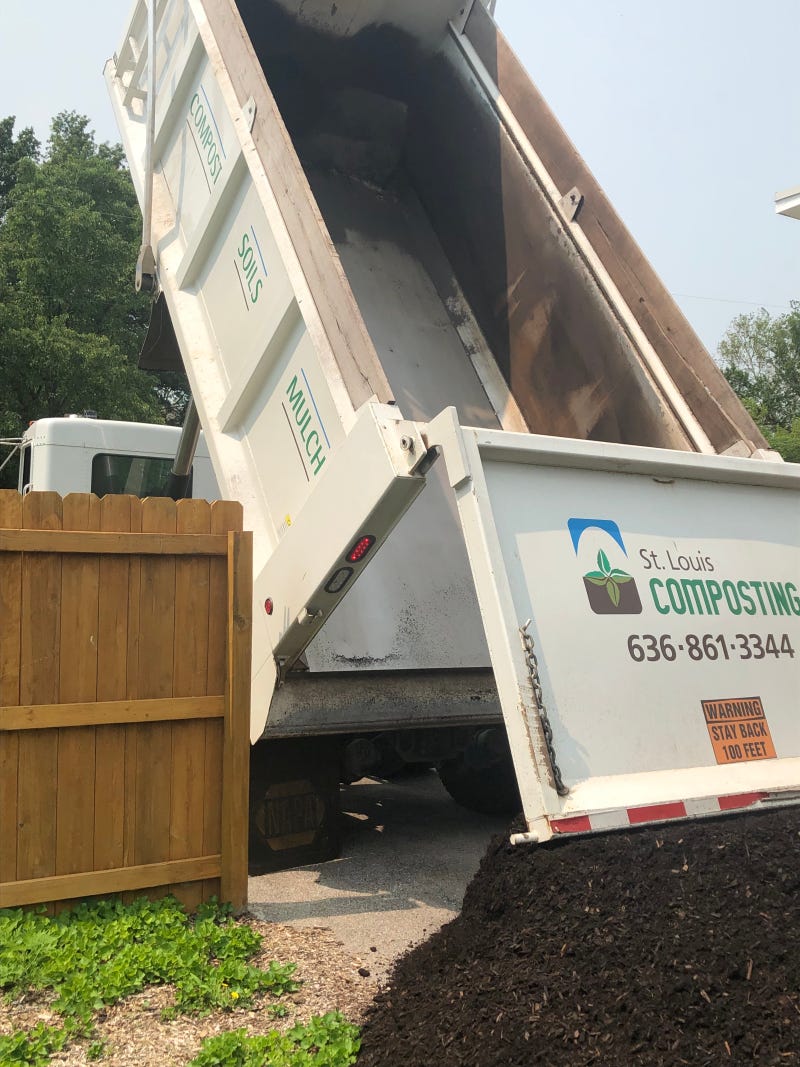
We continued to sheet-mulch the lawn throughout the fall, winter, spring, and summer of 2018-19, so that by August of 2019, we had more than half the ground covered. Here’s a panoramic image showing the wraparound fence, newly installed trees and other plants, and the sheet mulch.
Laying cardboard and shoveling mulch on top of it, especially over this much area, was a lot of hard work. But that meant we no longer had to mow the backyard. Besides, without the grass to compete with, our native violet ground cover took over on its own, and we liked it better than grass.
That said, the violets were the first succession, which later gave way to asters. We enjoy asters, but they are tall and aggressive, at least in our garden. In retrospect, we could have gone more slowly, planting a wide range of natives in clumps and waiting to see how those established before covering over all of the lawn. Of course, we wouldn’t then have earned a platinum award in just three years from the Audubon Society, but it would’ve been fine to slowly progress through silver to gold and then platinum.
In 2020, we added a long list of native trees, shrubs, and flowers, using thrifty resources provided by programs like the Missouri Department of Conservation's seedlings program, Grow Native! sales, and the free offerings of our local Wild Ones chapter. These plants filled out the landscape, taking the place of the invasives and attracting wildlife and pollinators in droves.
Our first official edible from the garden? Wild cleavers, which I harvested in spring 2019 for tea, as cleavers are an awesome tonic for reducing swelling and water retention. Next came basil in the summer.
By that winter, we had all but one small back strip converted from turf. In the spring of 2020, we let it go wild while we focused on sowing food plants in those sheet-mulched areas, which by that point were ready for more tender plantings. We also put in a squash tunnel, a rain garden, two hugelkultur mounds, and a wooden pergola.
Originally, the pergola supported two varieties of our native passionflower (AKA maypop), which spoiled the bees the first summer and yielded edible fruit. However, it dies back each winter and doesn’t grow enough in one season to cover the pergola, so I later replaced it with the very beautiful native Campsis radicans, or trumpet vine.
Since the beginning, we’ve made great use of our spring ephemerals, turning them into everything from tea to infused vinegar.
Even before we made the decision to replace the zig-zagging chainlink fence, we knew we wanted to screen the neighboring apartments with a row of tall evergreens.
We had a bit of a dilemma, though, as the usual recommendations for an evergreen privacy screen just weren’t suitable. Arborvitae is often used—too often, as it turns out—and the plant is suffering opportunistic disease as a result. We considered for a moment the lovely ‘bracken’s brown’ magnolia, with its velvety undercoat of brown fuzz on the leaves and distinctive cream blossoms, and we nearly got talked into it by folks at our local garden center. However, I was really committed to the native-plant mission, and neither magnolia nor arborvitae is native to Missouri.
A good native evergreen is eastern red cedar (Juniperus virginiana), but unfortunately, it grows too tall and wide to work as a screen in our narrow strip. However, the Audubon Society came up with a great solution: Juniperus virginiana ‘Taylor.’ That’s the tree you see going in here.
The Missouri Botanical Garden designated ‘Taylor’ as a “Plant of Merit,” and its history I’ll quote directly from their plant-finder listing:
‘Taylor’ is an upright narrow columnar eastern red cedar that typically grows to 15-20' tall but to only 3-4' feet wide. Silvery blue-green foliage is attractive throughout the growing season. Foliage may take on some bronze tones in winter. ‘Taylor’ was reportedly discovered in Taylor, Nebraska, as a chance seedling and was released in 1992 to the nursery trade by the Nebraska Statewide Arboretum.
I love that this “chance seedling” from the native eastern red cedar is the perfect narrowness and height to soften the fence line and help screen the view from the neighbors’ balconies without overwhelming the yard.
I’ve always enjoyed the look and scent of juniper berries. What really sold my husband on the Taylors is the fact that juniper berries are not only good for the birds, but they’re useful to humans as well. We’ve seen fronds laden with berries used to smoke salmon in the Pacific Northwest, and the berries have numerous culinary uses—from the obvious gin flavoring to the more obscure addition to fruitcake. I’ve used them in ferments.
We wanted to accomplish two things with our garden:
rescue our quarter-acre from exotic invasives and resource-intensive grass lawn and reframe it as an oasis for native pollinators and
blend that mission with our need to become much more self-sufficient with homegrown food and other products.
We managed to squeeze in a couple of true eastern red cedars as well, finds from a native-plant sale.
Note we planted all of these red cedars in the fall. A lot of people don’t know you can plant that time of year, but it’s actually better to put in trees and shrubs in autumn because they put their emphasis on building strong root structures to support the upward leaf growth in spring.
On the other side of the fence-line path went a beautiful Shumard oak and a black-gum tree. Nearer to the house, we added several persimmons and two serviceberries.
The persimmon is a special kind of fruit, as I covered in a recent article. I’m not talking about the Asian ones you get at the grocery store, but these yummy Midwestern natives. We’ve enjoyed them in many recipes since they began fruiting a few years ago.
We ask a lot of trees, and they give it.



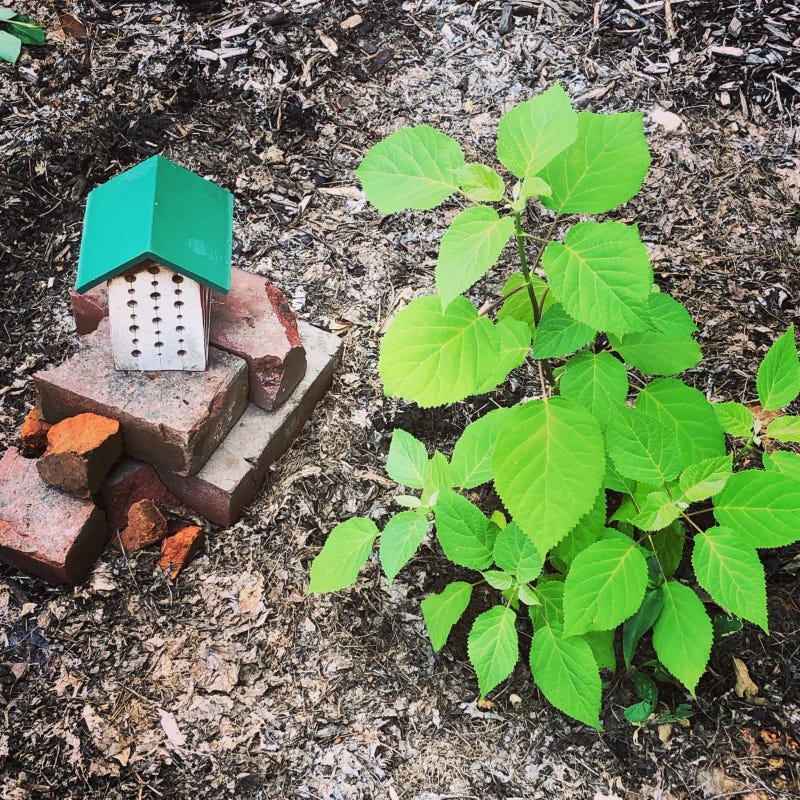
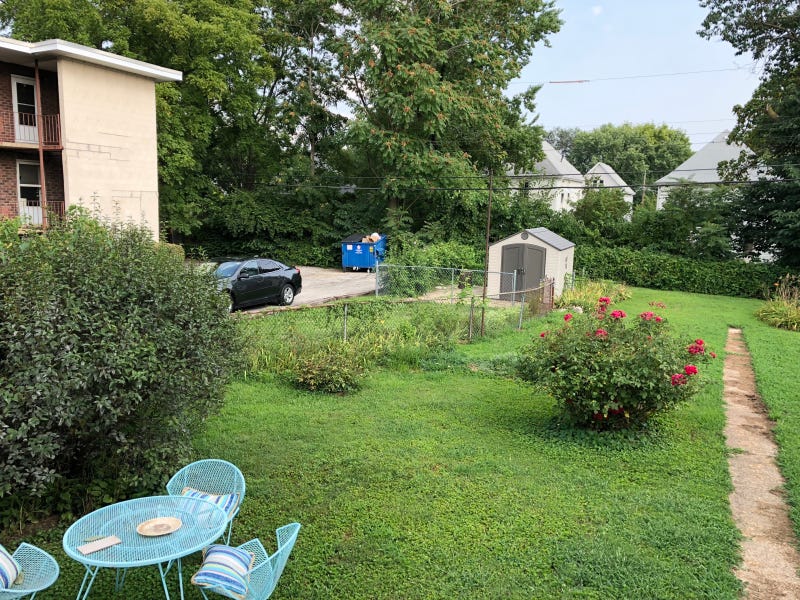
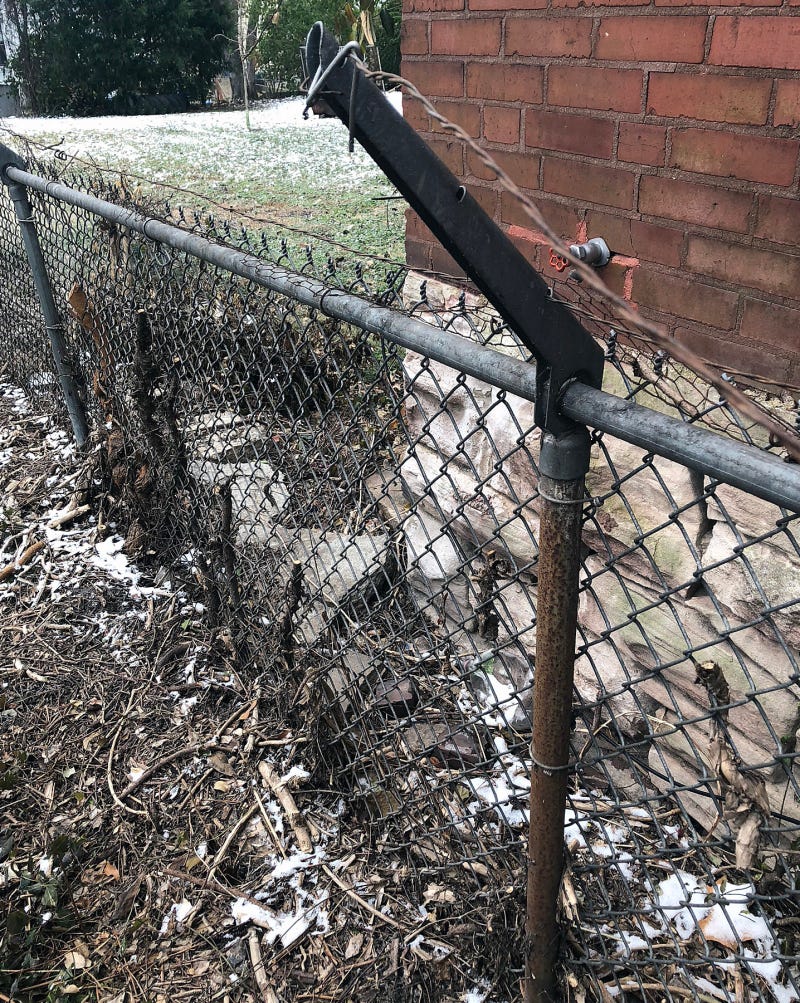


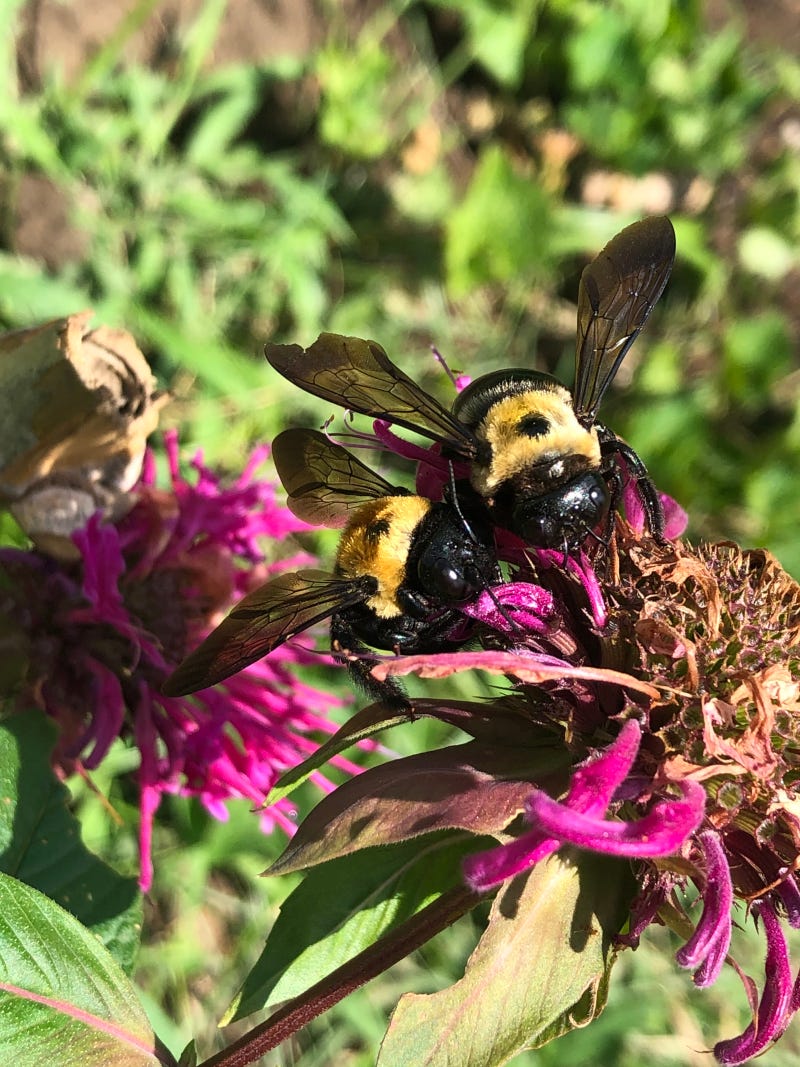
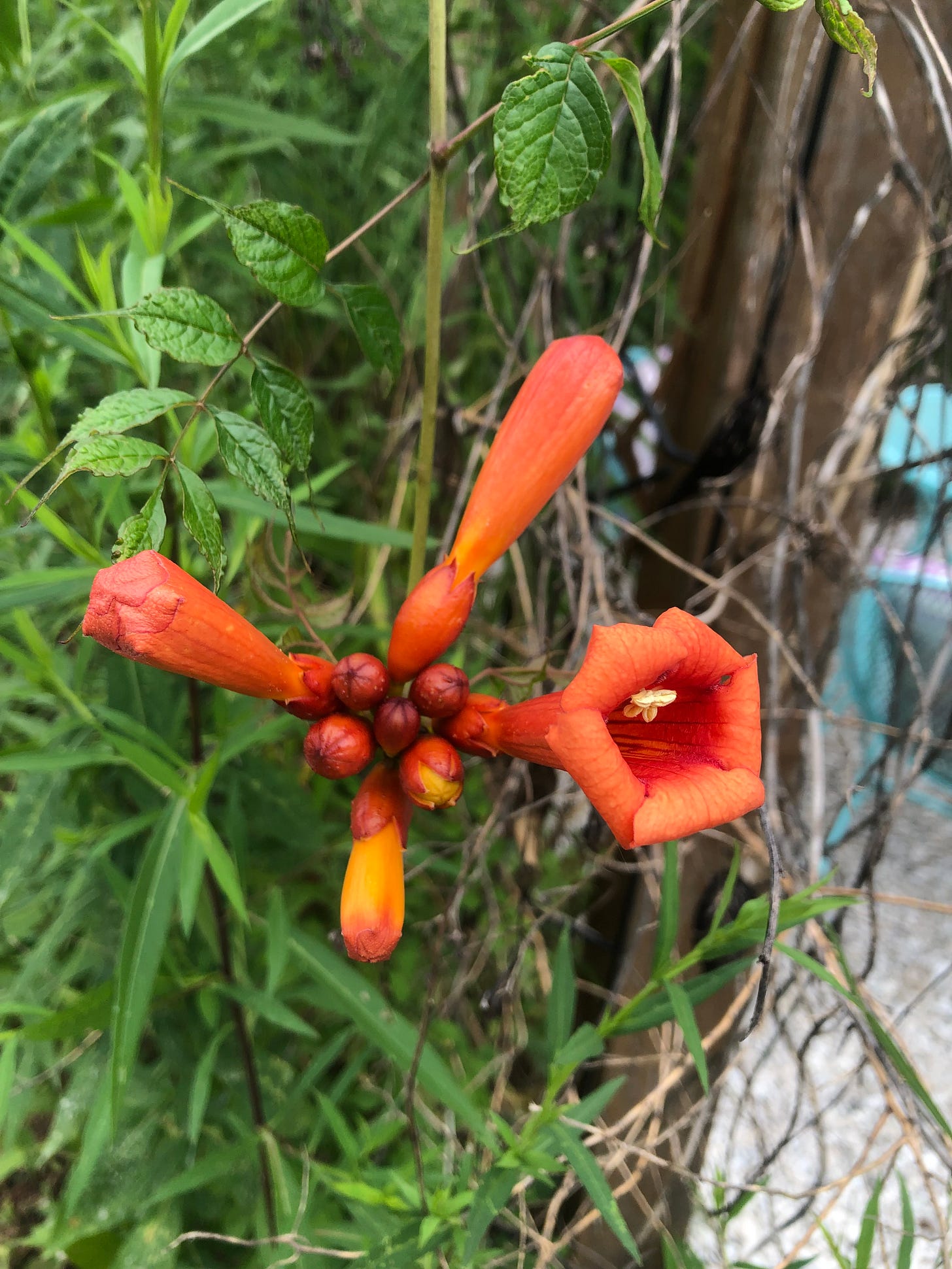
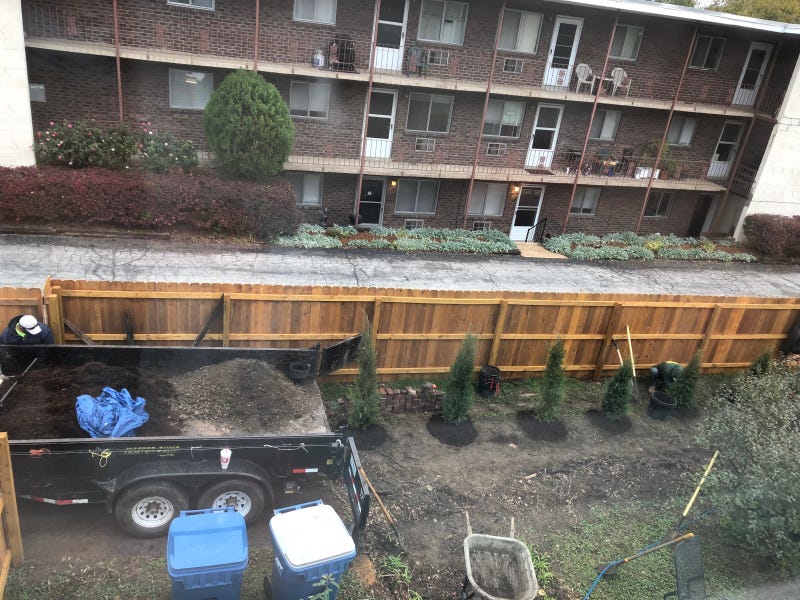
Congratulations on an enormous undertaking. I look forward to seeing your garden as it grows.